Consensual Negotiation-Based Decision Making for Connected Appliances in Smart Home Management Systems
Abstract
:1. Introduction
- Smart homes include different types of appliances with different properties and requirements. For instance, in the case of non-scheduled appliances such as lights, computers, televisions and so on, the comfort level of users is quite sensitive and their usage should not be delayed, whenever users require them to be used. In this regard, user satisfaction becomes a challenge that needs to be taken into account. Moreover, the state-of-the-art approaches for smart HEMS focus on centralized management by applying optimizing algorithms such as GA or Particle Swarm Optimization (PSO), which have to face hard computational problems, especially in the case of a high density of connected appliances.
- With the rapid development of IoT, a massive number of electrical appliances will be connected in the near future. In this regard, current approaches with centralized control model (e.g., HEMS controller) have to face the scalability problem in complex systems.
- Furthermore, the power utilization of renewable energy sources keep changing depending on the ambient environment (e.g., time, weather, geography location and so on). Thereby, real-time analytics with self-adaptive management is required for the energy monitoring and dynamic scheduling of home appliances.
1.1. Motivation
1.2. Contributions and Organization
- We first present a sustainable framework for HEMS in terms of communicating and collaborating among connected objects in a connected environment in an IoT system.
- Based on the proposed framework, we propose a new algorithm for dynamic scheduling connected appliances by applying negotiation, which is a powerful approach for solving the conflict problem in a complex system. In particular, individual decision-making based on negotiation is considered as a potential approach for pushing intelligence in connected objects, which is the core goal for the future of IoT development.
- Moreover, we design and simulate a smart home environment for evaluating the capabilities of proposed approach by using Netlogo, a tool for real-time analysis, an important element for adaptive systems in HEMS.
2. Background and Literature Review
2.1. Connectivity Infrastructure for the Home-IoT Ecosystem
2.2. Agent Technologies for Negotiation Model-Based Smart Decision-Making
- Theoretical models for describing, specifying, and reasoning about the key features of negotiating agents.
- Computational models for specifying the key data structures of negotiating agents and the processes operating on these structures.
3. Internet of Agent Framework among Connected Appliances for Smart HEMS
- Non-scheduled Appliance (): the appliances which rely on manual control to complete a task and need to operate when customers are home such as lights, ovens, and battery chargers. For the comfort level of customers, the usage of non-scheduled appliances should not be delayed.
- Scheduled Appliance (): the appliances that can complete a task without any manual control, such as washing machines, dryers, electric cars, water heater and so on. Additionally, scheduled appliances are divided into two types of load shift models (LSM): generic load (GL) and flexible load (FL) shift models (Figure 5).
- Supply Appliance : the appliances which provide energy for running appliances such as solar panels, and wind turbines.
- is the identification of agent. Technically, each agent has their own id number.
- is the set of relay ports (interface) which includes the set of agent input and output.
- : is the Knowledge base which perceives its environment through sensors (Figure 3).
- : is state engine which specifies behaviors of agent. The State Engine can be represented by a tuple as follows:where
- -
- is action set. The action represents the possible activities of the agent which includes the starting time and end time . For instance, Figure 6 depicts the list of status (actions) of appliances.
- -
- is the set of message exchanges including incoming and outgoing messages.
- -
- : is the electric utility function when an agent implements an action .
- -
- : is the set of states of the agent. State of agent can be passive or active.
- REQUEST: When a connected appliance requests a turn on, it broadcasts a request message to use energy.
- REPLY: When a connected appliance receives a REQUEST message, it may respond with a REPLY message or add the REQUEST message in its pending list.
- RELEASE: When connected appliances complete their operation, it broadcasts REPLY messages to all requests in its pending list.
4. Problem Formulation
4.1. Energy Consumption Formulation
4.2. Rule-Based Smart Home Energy System
- Total power consumption of appliances at each time slot should be limited to the allotted load capacity (Equation (4)).
- When the supply power is available, it should be prioritized for assigning to the appliances.
- The non-scheduled appliance would not be delayed and the status always switches ON when they send a request message.
- In the case of scheduled appliances, the one in a higher priority level is prioritized to use the resource.
4.3. Consensual Negotiation Model for Decentralized Decision-Making among Connected Appliances
- Requesting for the operation: send .
- Executing the operation: receive .
- Release after the operation: send .
5. Consensual Negotiation-Based for Dynamic Load Balancing in Smart HEMS
- (i)
- When a connected appliance requires an active operation, it sends a Request Message to all appliances that are operating and waits for their permission (Algorithm 1):
- If appliance belongs to , it changes state (:= On) and notifies all other appliances.
- If appliance belongs to , it will send a request message which includes the operation time (), the deadline (), and waiting for the reply message from others (:= Waiting).
- If appliance belongs to , surplus power () will be computed.
- (ii)
- When connected appliance receives a request message from (Algorithm 2), it first checks the condition following Equation (4):
- In the case that the current power consumption is lower than the allotted load capacity ():
- -
- If the request message from appliance belongs to or , the appliance only needs to update the information as their knowledge base () of the environment.
- -
- On the other hand, if the request message from the appliance is , the priority level of two appliances will be taken into consideration (Equation (6)). Specifically, the appliance should send a Reply message if the priority rate of the appliance which sends the request is larger than . Otherwise, the request message will be put in the pending list of appliance .
- In the case that current power consumption is lower than the allotted load capacity ), some appliances in the flexible load shift model, which are operating, can be switched to Inactive based on priority level to maintain the load balancing.
- (iii)
- As a result, an appliance, which belongs to , can switch on when it receives all reply messages from others. In addition, when the appliances complete their operation, they should send a reply message to all the request messages in their pending list (Algorithm 3).
| Algorithm 1: Request message of connected appliances |
 |
| Algorithm 2: Reply message of connected appliances |
 |
| Algorithm 3: Release message of connected appliances |
 |
6. Simulation and Discussion
6.1. Developing a Smart HEMS Environment
6.2. Numerical Results and Discussion
7. Conclusions
Author Contributions
Funding
Conflicts of Interest
References
- Zhou, B.; Li, W.; Chan, K.W.; Cao, Y.; Kuang, Y.; Liu, X.; Wang, X. Internet of Things (IoT): A vision, architectural elements, and future directions. Futur. Gener. Comput. Syst. 2016, 29, 1645–1660. [Google Scholar] [CrossRef]
- Zhou, B.; Li, W.; Chan, K.W.; Cao, Y.; Kuang, Y.; Liu, X.; Wang, X. Smart home energy management systems: Concept, configurations, and scheduling strategies. Renew. Sustain. Energy Rev. 2016, 61, 30–40. [Google Scholar] [CrossRef]
- Alahakoon, D.; Yu, X. Smart electricity meter data intelligence for future energy systems: A survey. IEEE Trans. Ind. Inform. 2016, 12, 425–436. [Google Scholar] [CrossRef]
- Han, J.; Choi, C.S.; Park, W.K.; Lee, I.; Kim, S.H. Smart home energy management system including renewable energy based on ZigBee and PLC. IEEE Trans. Consum. Electron. 2014, 60, 198–202. [Google Scholar] [CrossRef]
- Zhao, Z.; Lee, W.C.; Shin, Y.; Song, K.B. An optimal power scheduling method for demand response in home energy management system. IEEE Trans. Smart Grid 2014, 4, 1391–1400. [Google Scholar] [CrossRef]
- Ozturk, Y.; Senthilkumar, D.; Kumar, S.; Lee, G. An intelligent home energy management system to improve demand response. IEEE Trans. Smart Grid 2013, 4, 694–701. [Google Scholar] [CrossRef]
- Althaher, S.; Mancarella, P.; Mutale, J. Automated demand response from home energy management system under dynamic pricing and power and comfort constraints. IEEE Trans. Smart Grid 2015, 6, 1874–1883. [Google Scholar] [CrossRef]
- Brahman, F.; Honarmand, M.; Jadid, S. Optimal electrical and thermal energy management of a residential energy hub, integrating demand response and energy storage system. Energy Build. 2015, 6, 65–75. [Google Scholar] [CrossRef]
- Muralitharan, K.; Sakthivel, R.; Shi, Y. Multiobjective optimization technique for demand side management with load balancing approach in smart grid. Neurocomputing 2016, 177, 110–119. [Google Scholar] [CrossRef]
- Stojkoska, B.L.R.; Trivodaliev, K.V. A review of Internet of Things for smart home: Challenges and solutions. J. Clean. Prod. 2017, 140, 1454–1464. [Google Scholar] [CrossRef]
- Satyanarayanan, M.; Simoens, P.; Xiao, Y.; Pillai, P.; Chen, Z.; Ha, K.; Hu, W.; Amos, B. Edge analytics in the internet of things. IEEE Pervasive Comput. 2017, 14, 24–31. [Google Scholar] [CrossRef]
- Kahrobaee, S.; Rajabzadeh, R.A.; Soh, L.K.; Asgarpoor, S. A multiagent modeling and investigation of smart homes with power generation, storage, and trading features. IEEE Trans. Smart Grid 2013, 4, 659–668. [Google Scholar] [CrossRef]
- Al-Fuqaha, A.; Guizani, M.; Mohammadi, M.; Aledhari, M.; Ayyash, M. Internet of Things: A Survey on Enabling Technologies, Protocols, and Applications. IEEE Commun. Surv. Tutor. 2015, 17, 2347–2376. [Google Scholar] [CrossRef]
- Ballard, A.B.; Kling, W.L.; Ribeiro, P.F. Multi-agent system architecture for smart home energy management and optimization. In Proceedings of the 4th IEEE International Conference on Innovative Smart Grid Technologies Europe (ISGT EUROPE), Lyngby, Denmark, 6–9 October 2013; pp. 1–5. [Google Scholar] [CrossRef]
- Yu, H.; Shen, Z.; Leung, C. From internet of things to internet of agents. In Proceedings of the 2013 IEEE International Conference on Green Computing and Communications (GreenCom), Beijing, China, 20–23 August 2013; pp. 1054–1057. [Google Scholar] [CrossRef]
- Bui, K.H.N.; Jung, J.E.; Camacho, D. Game theoretic approach on real-time decision-making for IoT-based traffic light control. Concurr. Comput. Pract. Exp. 2017, 29, e4077. [Google Scholar] [CrossRef]
- Bui, K.H.N.; Camacho, D.; Jung, J.E. Real-time traffic flow management based on inter-object communication: a case study at intersection. Mob. Netw. Appl. 2017, 22, 613–624. [Google Scholar] [CrossRef]
- Bui, K.H.N.; Jung, J.J. Internet of agents framework for connected vehicles: A case study on distributed traffic control system. J. Parallel Distrib. Comput. 2017, 116, 89–95. [Google Scholar] [CrossRef]
- Bui, K.H.N.; Jung, J.J. Cooperative game-theoretic approach to traffic flow optimization for multiple intersections. Comput. Electr. Eng. 2017. [Google Scholar] [CrossRef]
- Lopes, F.; Wooldridge, M.; Novais, A.Q. Negotiation among autonomous computational agents: Principles, analysis and challenges. Artif. Intell. Rev. 2008, 29, 1–44. [Google Scholar] [CrossRef]
- Silva, B.N.; Khan, M.; Han, K. Load Balancing Integrated Least Slack Time-Based Appliance Scheduling for Smart Home Energy Management. Sensors 2018, 18, 685. [Google Scholar] [CrossRef] [PubMed]
- Labrou, Y.; Finin, T.; Peng, Y. Agent communication languages: The current landscape. IEEE Intell. Syst. 1999, 14, 45–52. [Google Scholar] [CrossRef]
- Ren, F.; Lin, C. Modeling and improving TCP performance over cellular link with variable bandwidth. IEEE Trans. Mob. Comput. 2011, 10, 1057–1070. [Google Scholar] [CrossRef]
- Adika, C.O.; Wang, L. Autonomous appliance scheduling for household energy management. IEEE Trans. Smart Grid 2014, 5, 673–682. [Google Scholar] [CrossRef]
- Pilloni, V.; Floris, A.; Meloni, A.; Atzori, L. Smart home energy management including renewable sources: A QOE-driven approach. IEEE Trans. Smart Grid 2016, 9, 2006–2018. [Google Scholar] [CrossRef]
- Perera, C.; Liu, C.H.; Jayawardena, S. The emerging internet of things marketplace from an industrial perspective: A survey. IEEE Trans. Emerg. Top. Comput. 2015, 3, 585–598. [Google Scholar] [CrossRef]
- Hwang, M.; Choi, D.; Kim, P. Least slack time rate first: New scheduling algorithm for multi-processor environment. In Proceedings of the 2010 IEEE International Conference on Complex, Intelligent and Software Intensive Systems (CISIS), Krakow, Poland, 15–18 February 2010; pp. 806–811. [Google Scholar] [CrossRef]
- Alhafidh, B.M.; Allen, W. Design and simulation of a smart home managed by an intelligent self-adaptive system. Int. J. Eng. Res. Appl. 2018, 6, 64–90. [Google Scholar]
- Hussain, H.M.; Javaid, N.; Iqbal, S.; Hasan, Q.U.; Aurangzeb, K.; Alhussein, M. An Efficient Demand Side Management System with a New Optimized Home Energy Management Controller in Smart Grid. Energies 2018, 11, 190. [Google Scholar] [CrossRef]

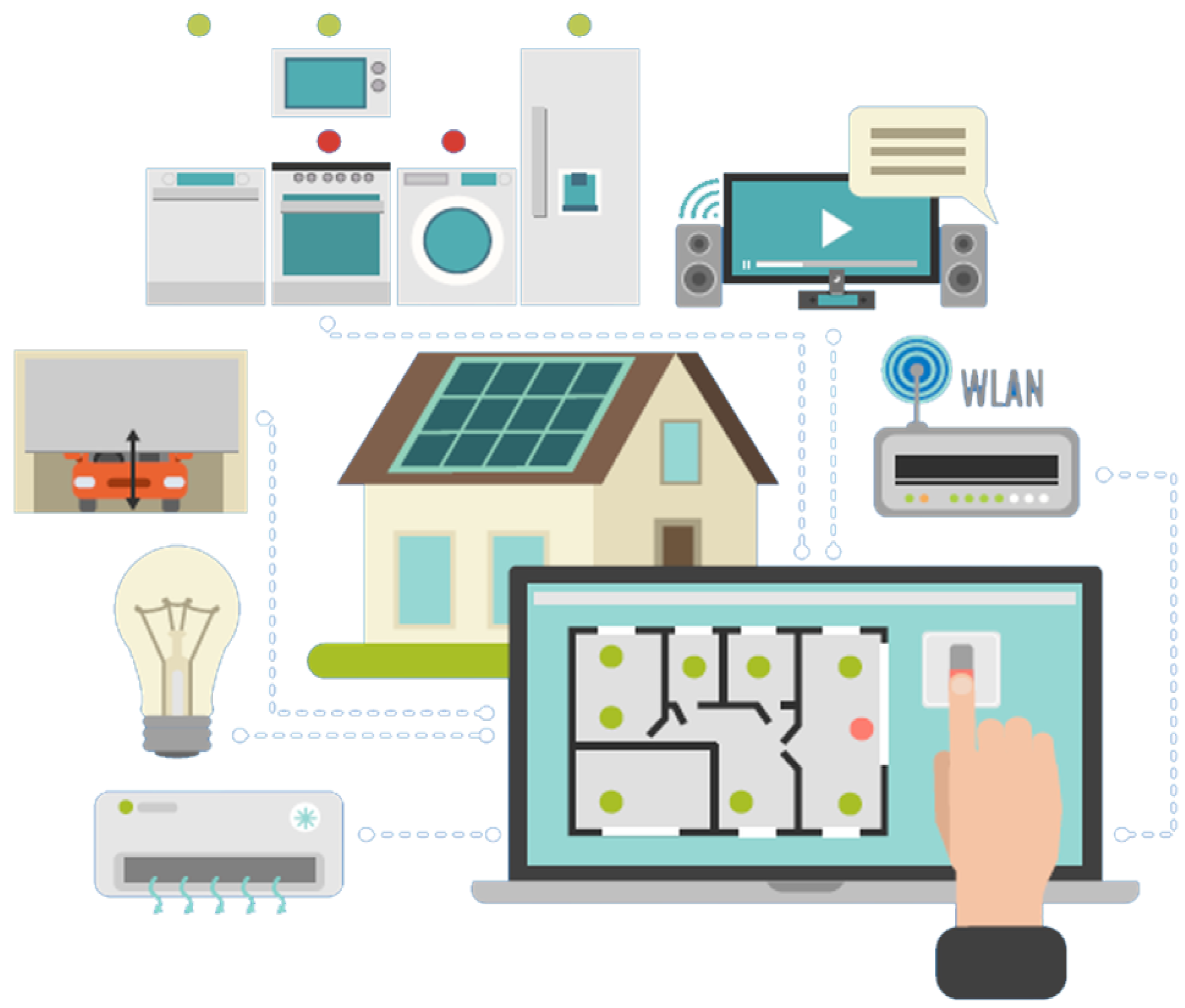
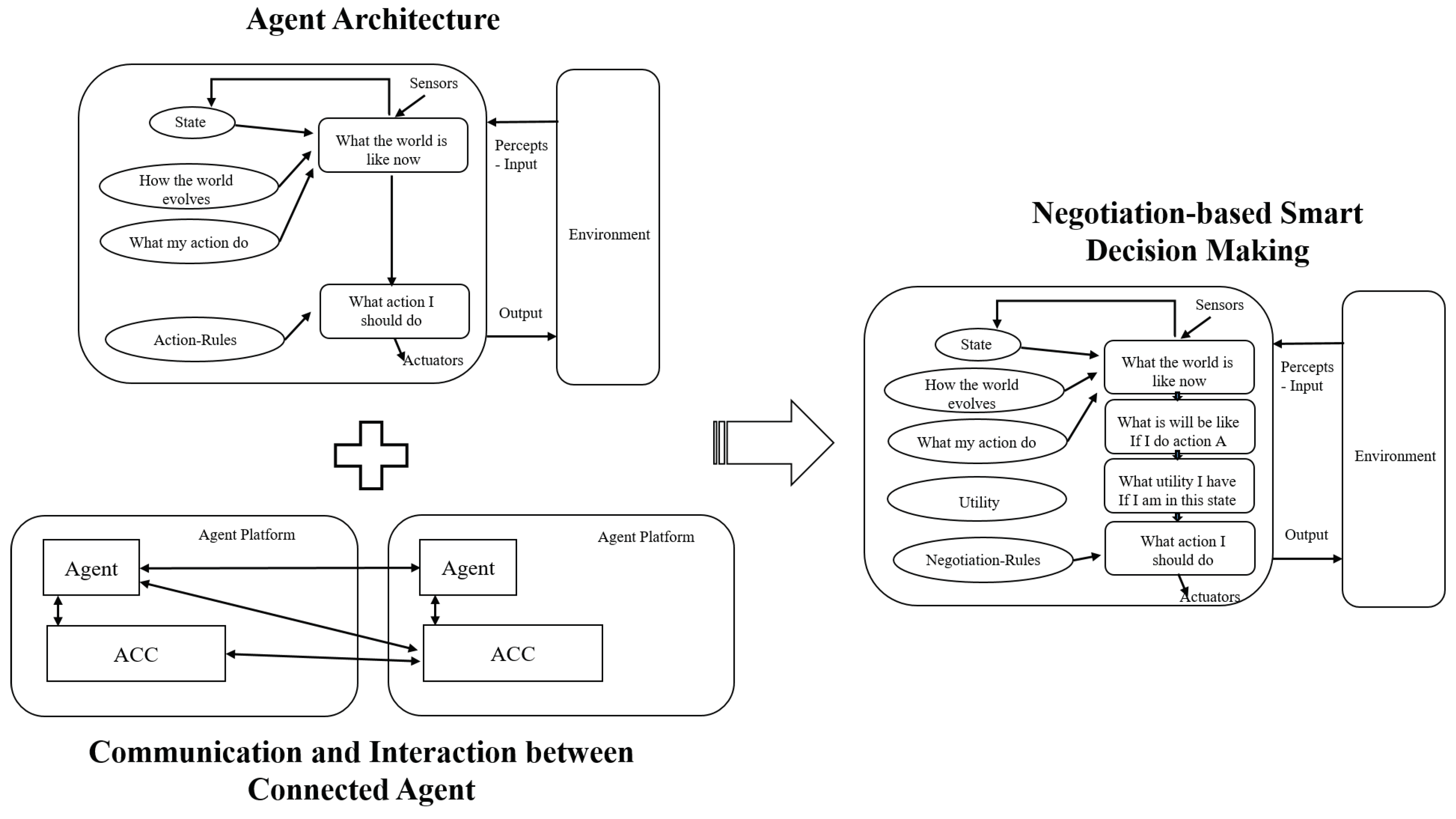
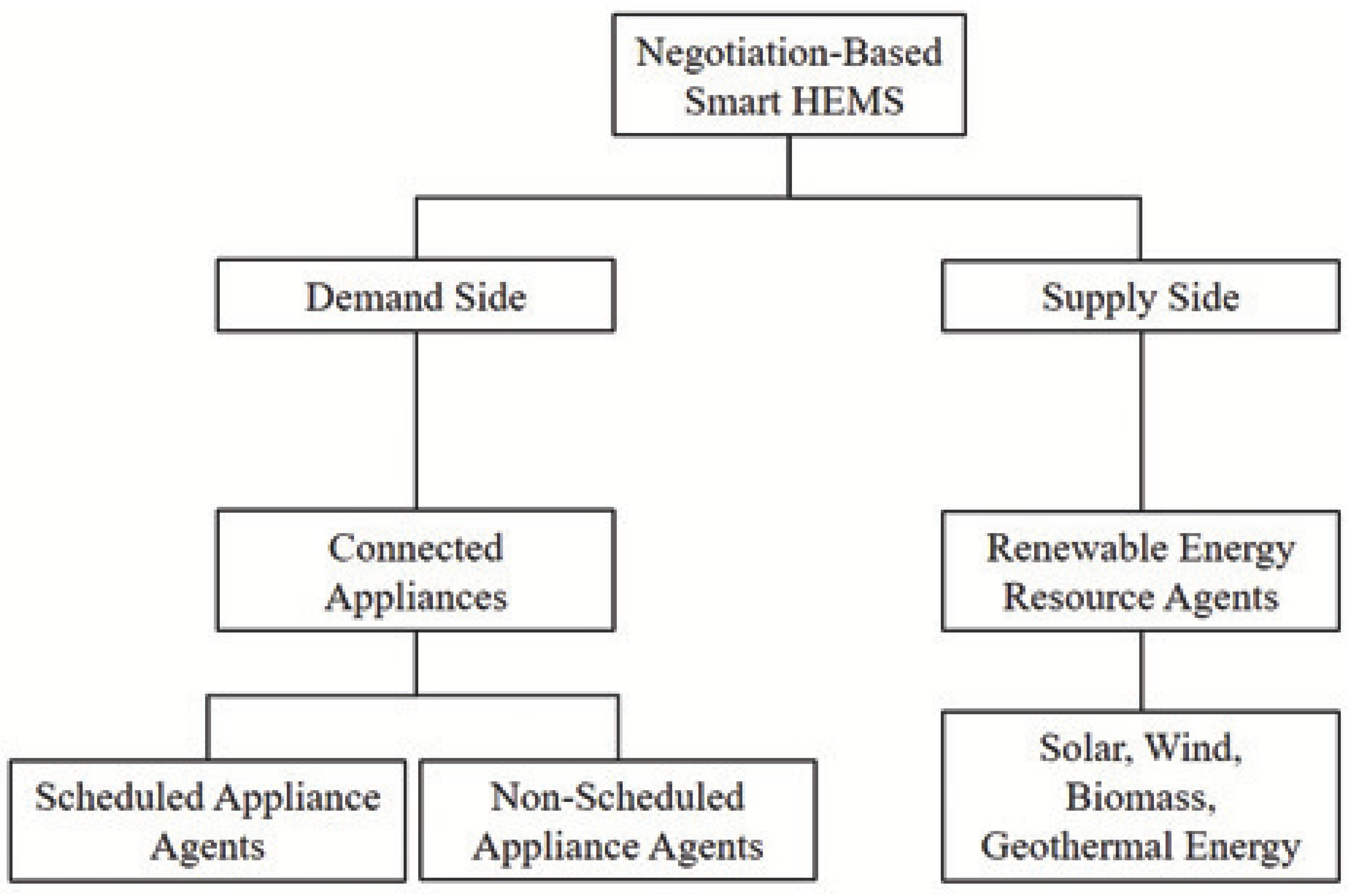
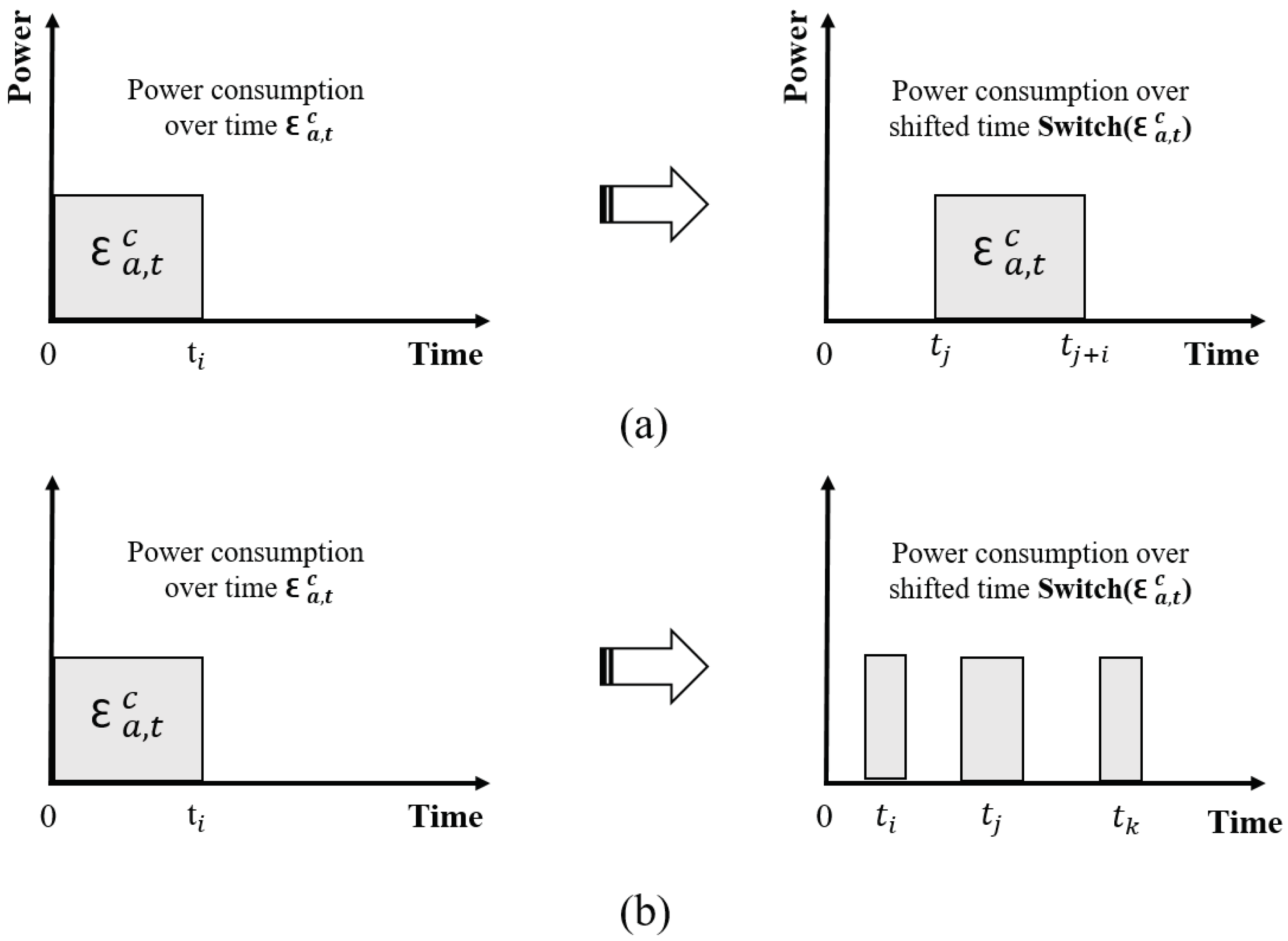
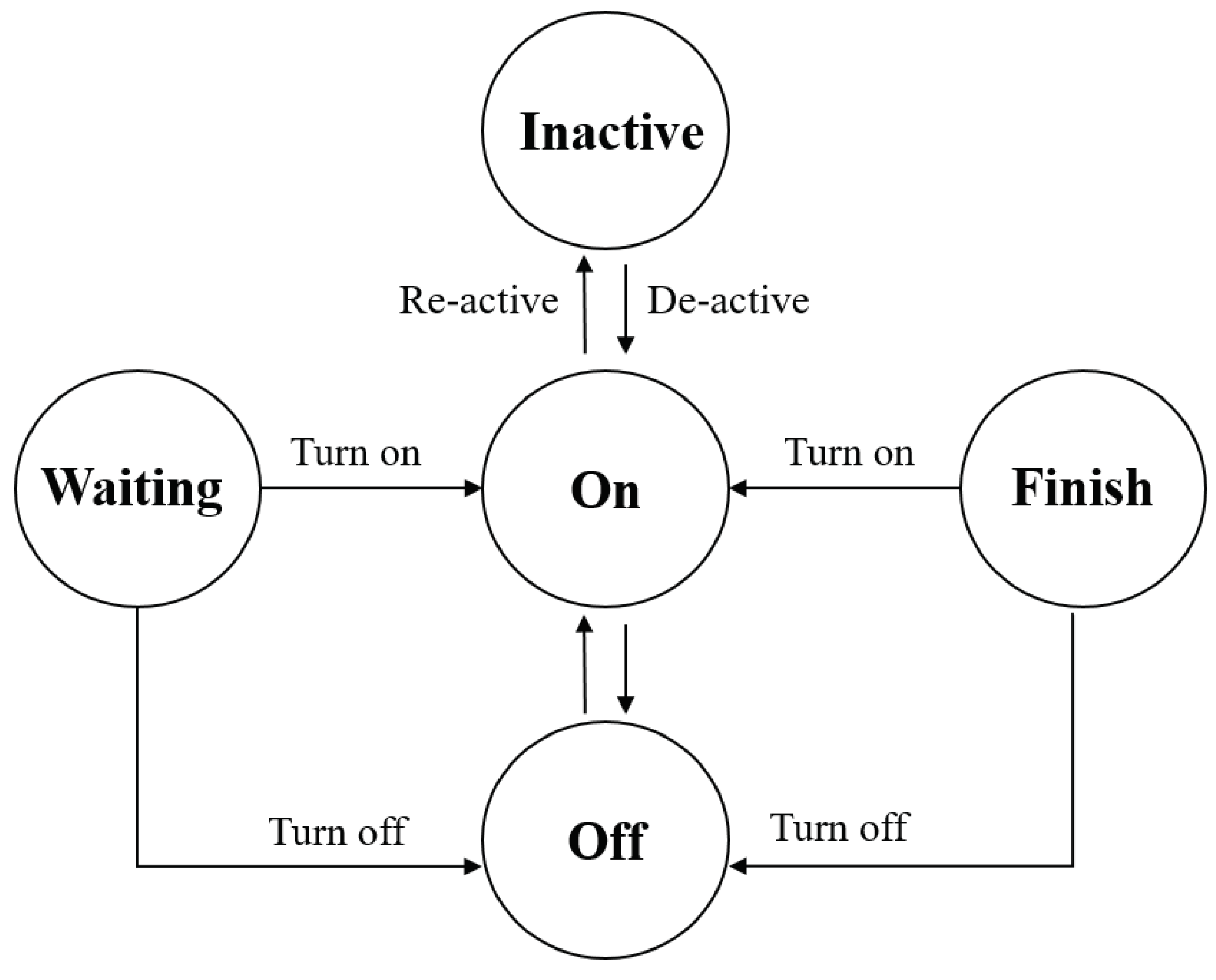
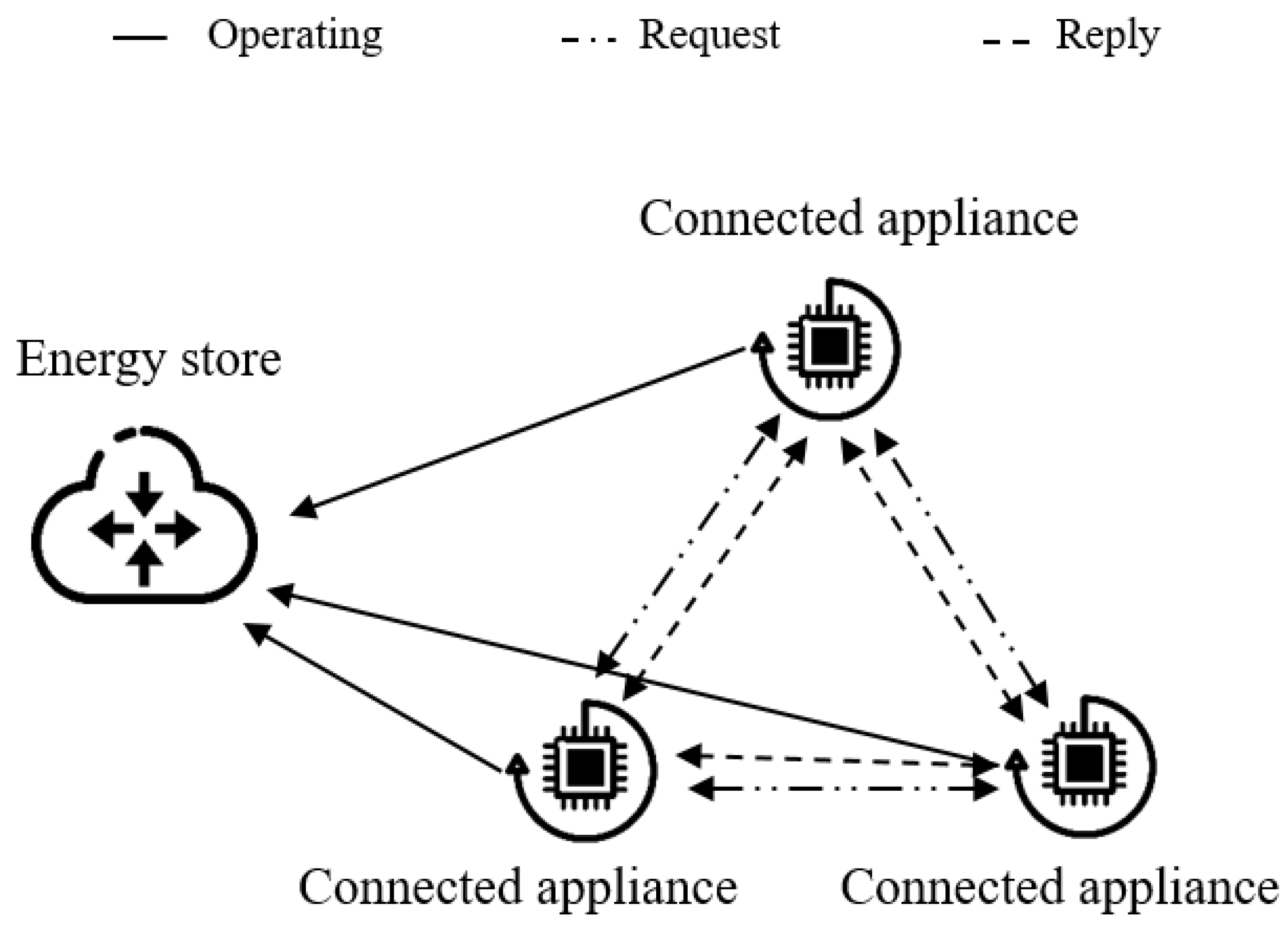
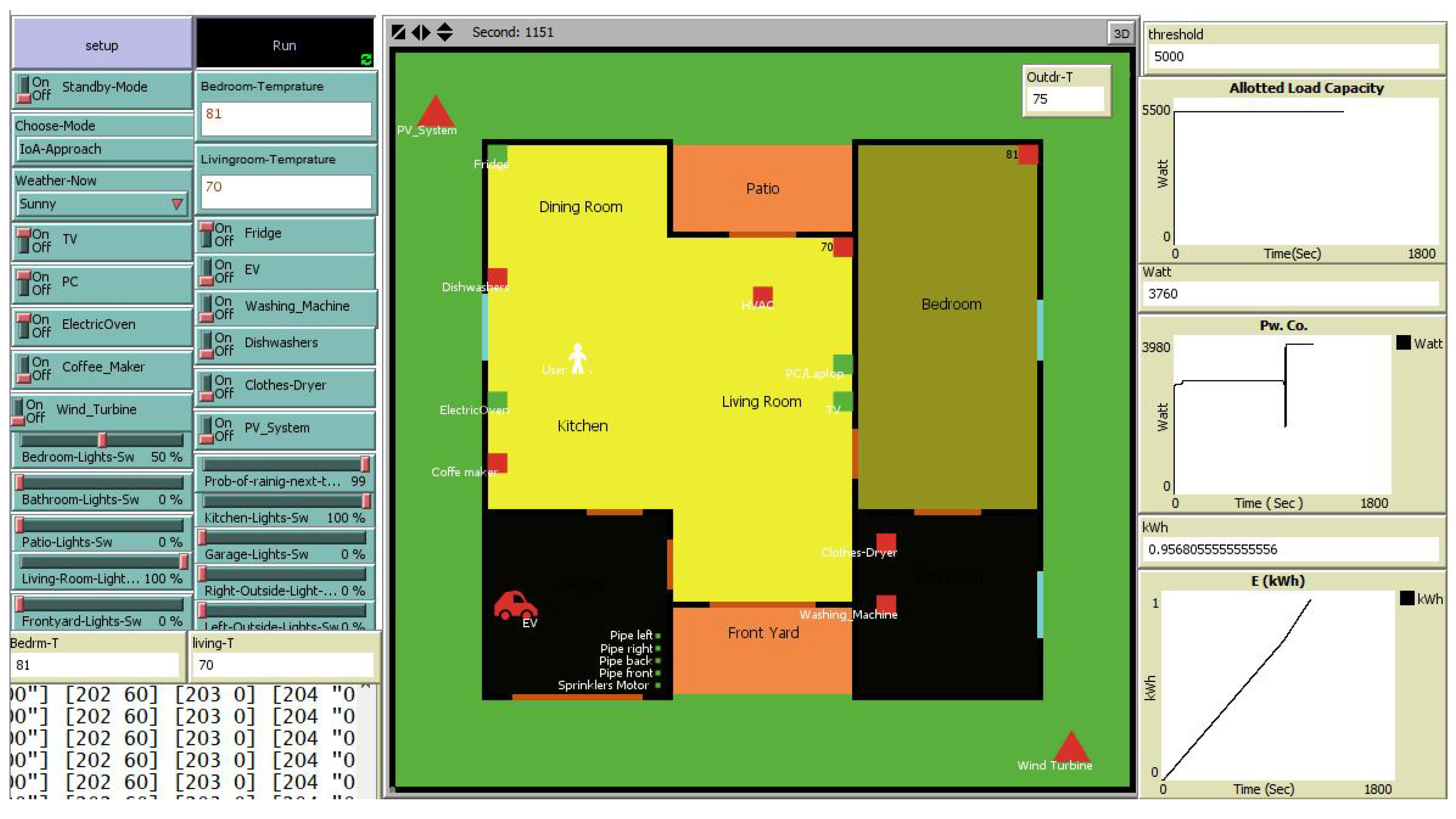
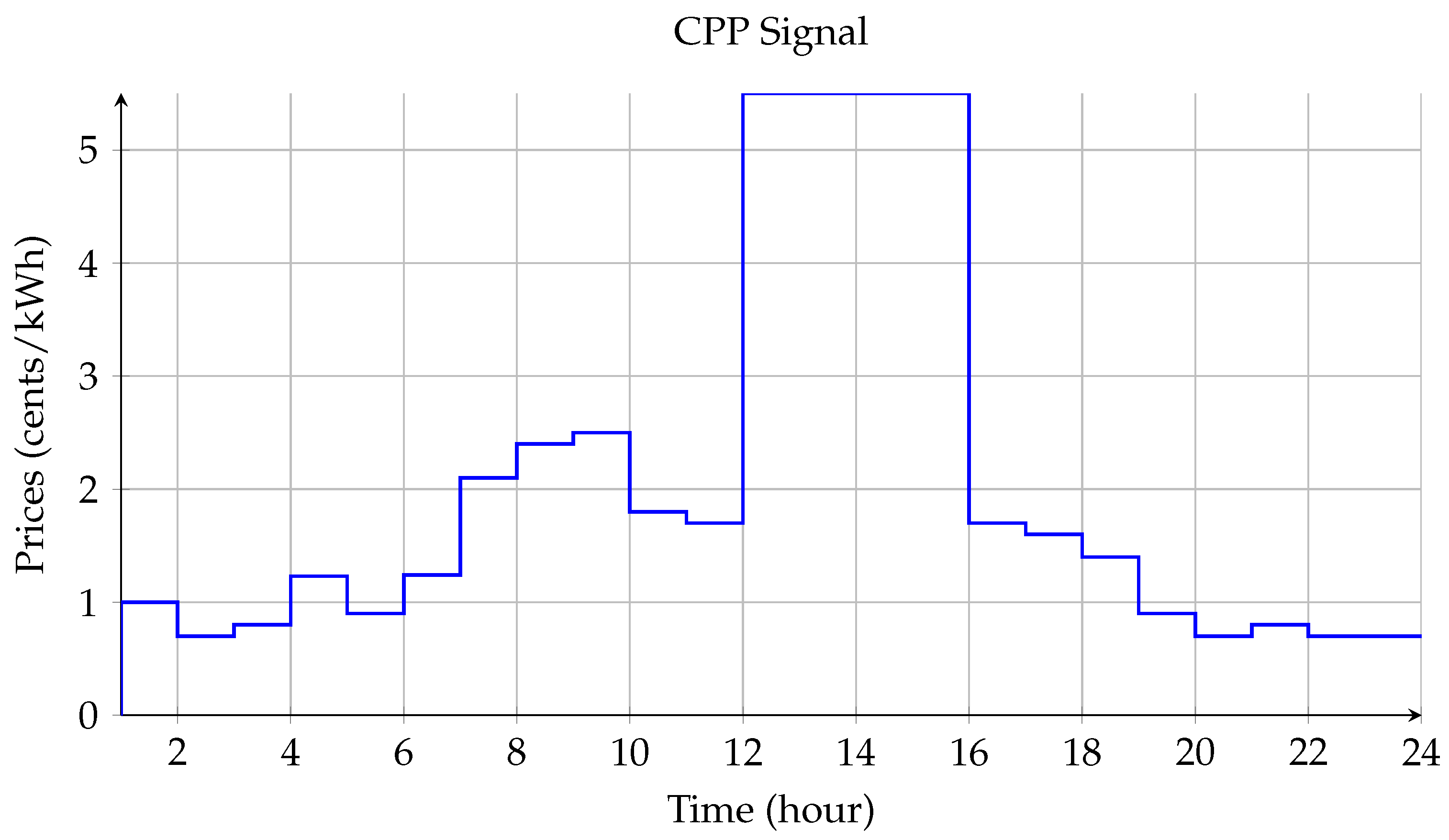
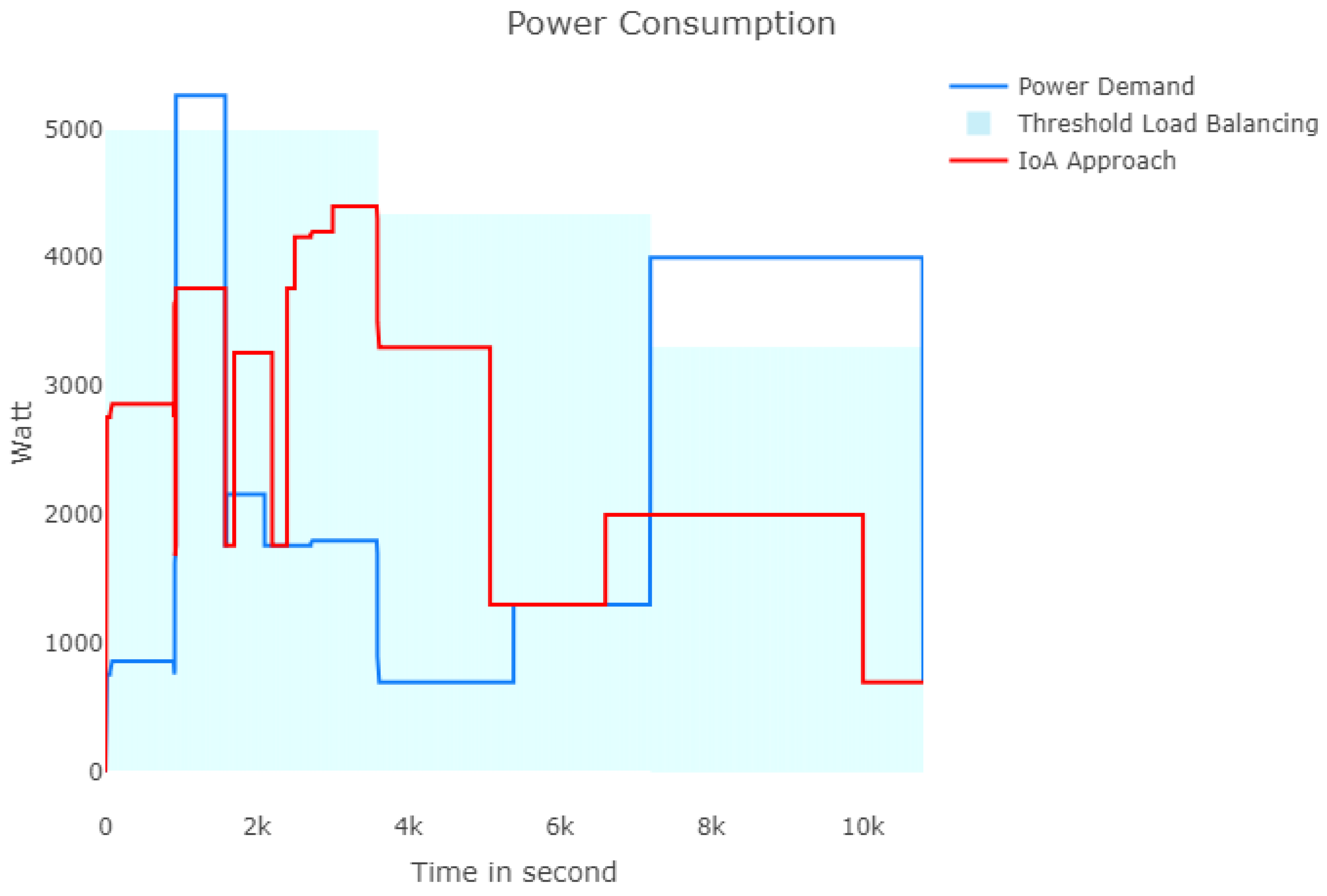

| Appliance List | ||||
|---|---|---|---|---|
| No. | Appliance Name | Type of Appliances | Load Shift Model | Power Rating (KW) |
| 1 | Fridge/freezer | NA | 0.7 | |
| 2 | Lighting | NA | 0.4 | |
| 3 | TV | NA | 0.3 | |
| 4 | PC/laptop | NA | 0.5 | |
| 5 | Coffee Maker | NA | 1.5 | |
| 6 | Washing machine | FL | 0.6 | |
| 7 | Dishwasher | GL | 0.4 | |
| 8 | Clothes dryer | FL | 1.3 | |
| 9 | Electric oven | GL | 2 | |
| 10 | HVAC | FL | 1 | |
| 11 | Electric vehicle | , | FL | 2 |
| 12 | PV system | NA | ||
| 13 | Wind turbine | NA | ||
| No. | Appliance Name | Type | Time Operation (min) | Probability |
|---|---|---|---|---|
| 1 | Fridge/freezer | Always on | 100% | |
| 2 | Lighting | Depend on consumers | 100% | |
| 3 | TV | 40 | 100% | |
| 4 | PC/laptop | 40 | 95% | |
| 5 | Coffee Maker | 8 | 53% | |
| 6 | Washing machine | 60 | 86% | |
| 7 | Dishwasher | 8 | 34% | |
| 8 | Clothes dryer | 60 | 8% | |
| 9 | Electric oven | 8 | 53% | |
| 10 | HVAC | Depend on consumers | 31% | |
| 11 | Electric vehicle | , | 60 | 50% |
| 12 | PV system | NA | 10% | |
| 13 | Wind turbine | NA | 10% |
© 2018 by the authors. Licensee MDPI, Basel, Switzerland. This article is an open access article distributed under the terms and conditions of the Creative Commons Attribution (CC BY) license (http://creativecommons.org/licenses/by/4.0/).
Share and Cite
Bui, K.-H.N.; Jung, J.J.; Camacho, D. Consensual Negotiation-Based Decision Making for Connected Appliances in Smart Home Management Systems. Sensors 2018, 18, 2206. https://doi.org/10.3390/s18072206
Bui K-HN, Jung JJ, Camacho D. Consensual Negotiation-Based Decision Making for Connected Appliances in Smart Home Management Systems. Sensors. 2018; 18(7):2206. https://doi.org/10.3390/s18072206
Chicago/Turabian StyleBui, Khac-Hoai Nam, Jason J. Jung, and David Camacho. 2018. "Consensual Negotiation-Based Decision Making for Connected Appliances in Smart Home Management Systems" Sensors 18, no. 7: 2206. https://doi.org/10.3390/s18072206
APA StyleBui, K.-H. N., Jung, J. J., & Camacho, D. (2018). Consensual Negotiation-Based Decision Making for Connected Appliances in Smart Home Management Systems. Sensors, 18(7), 2206. https://doi.org/10.3390/s18072206







